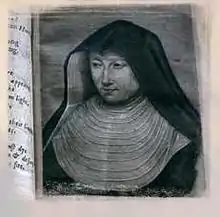Gertrude More
Dame Gertrude More (born as Helen More; 25 March 1606 - 17 August 1633) was a nun of the English Benedictine Congregation, a writer and chief founder of Stanbrook Abbey.

She was born in Low Leyton, Essex, England. Her father, Cresacre More, was great-grandson of Thomas More; her mother, Elizabeth Gage, was sister of Sir John Gage, 1st Baronet of Firle, Sussex, Lord Chamberlain to Queen Mary. Her mother died at early age and Helen's father became responsible for her care and education. Dom Benet Jones, a Benedictine monk, encouraged her to join his projected religious foundation, Our Lady of Comfort, in Cambrai. She was the first of nine postulants admitted to the order on 31 December 1623. Helen More came under the influence of Augustine Baker and took the religious name of Gertrude. Catherine Gascoigne, one of her peers, was chosen ahead of her as abbess.
Her writing was heavily influenced by the christian mystics such as Julian of Norwich and Teresa of Avila and other spiritual writers[1] and she contributed to the effort to publish their work.[2][3]
Later, doubts arising as to More's mode of prayer, formal inquiry was made, resulting in approval at the General Chapter in 1633 during the sessions of which Dame Gertrude died at Cambrai, France, from smallpox, aged 27.
Posthumous
Some papers found after her death and arranged by Father Baker, were afterwards published in two separate works: one entitled The Holy Practices of a Divine Lover, or the Sainctly Ideot's Devotions (Paris, 1657); the other, Confessiones Amantis, or Spiritual Exercises, or Ideot's Devotions, to which was prefixed her Apology, for herself and for her spiritual guide (Paris, 1658).
References
- Latz, Dorothy L. (1990). "The Mystical Poetry of Dame Gertrude More". Mystics Quarterly. 16 (2): 66–82. ISSN 0742-5503. JSTOR 20716980.
- "Dame Gertrude More on Father Augustine's Way of Prayer"". www.umilta.net. Retrieved 2020-04-22.
- "Julian of Norwich: Janina Ramirez hails 'the female Chaucer'". HistoryExtra. Retrieved 2020-04-22.